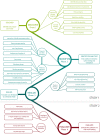How to use participatory design to develop an eHealth intervention to reduce preprocedural stress and anxiety among children visiting the hospital: The Hospital Hero app multi-study and pilot report
- PMID: 36865696
- PMCID: PMC9971988
- DOI: 10.3389/fped.2023.1132639
How to use participatory design to develop an eHealth intervention to reduce preprocedural stress and anxiety among children visiting the hospital: The Hospital Hero app multi-study and pilot report
Abstract
Background: Medical procedures can cause considerable stress and anxiety among children. Current interventions mainly diminish stress and anxiety during procedures, while stress and anxiety often build up at home. Moreover, interventions often focus on either distraction or preparation. eHealth can combine multiple strategies and provide a low-cost solution that can be used outside the hospital.
Objective: To develop an eHealth solution to diminish preprocedural stress and anxiety, and to evaluate the app on use, usability and user experience in practice. We also aimed to gain in-depth insights in children's and caregivers' opinions and experiences to inform future improvements.
Methods: This is a multi-study report on the development (Study 1) and evaluation (Study 2) of a first version of the developed app. In study 1 we adopted a participatory design approach in which children's experiences were central to the design process. We performed an experience journey session with stakeholders (n = 13) to map the child's outpatient journey, identify pains and gains, and formulate the desired experience journey. Iterative development and testing with children (n = 8) and caregivers (n = 6) resulted in a working prototype. The prototype was tested with children, resulting in a first version of the Hospital Hero app. The app was evaluated on use, user-experience and usability during an eight-week pilot study in practice (Study 2). We triangulated data from online interviews with children and caregivers (n = 21) and online questionnaires (n = 46).
Results: Multiple stress and anxiety experience touchpoints were identified. The Hospital Hero app supports children in their hospital journey by facilitating preparation at home and providing distraction at the hospital. The pilot study showed that the app was evaluated positively on usability and user-experience and is considered feasible. Qualitative data showed five themes: (1) user-friendliness, (2) coherence and power of storytelling, (3) motivation and reward, (4) fit with real hospital journey, (5) procedural comfort.
Discussion: Using participatory design, we developed a child-centered solution that supports children in the entire hospital journey and may diminish preprocedural stress and anxiety. Future efforts should create a more tailored journey, define an optimal engagement window and formulate implementation strategies.
Keywords: anxiety; co-creation; coping; eHealth; participatory design (PD); procedural comfort.
© 2023 Poot, Meijer, Bruil, Venema, Vegt, Donkel, van Noort, Chavannes and Roest.
Conflict of interest statement
The Hospital Hero app and the interest from other hospitals led to foundation of the non-profit foundation Hospital Hero (founded August 2022). Authors Charlotte Poot and Nicole Donkel are the co-founders and board members of the foundation. Authors Eline Meijer and Arno Roest are members of the advisory board.
Figures





References
-
- Kazak AE, Kunin-Batson A. Psychological and integrative interventions in pediatric procedure pain. Acute and procedure pain in infants and children. Progress in pain research and management, Vol. 20. Seattle, WA, United States: IASP Press; (2001). p. 77–100.
LinkOut - more resources
Full Text Sources

